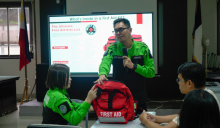
Employees, interns—even visitors—took part of NIA Region VII Earthquake Lecture and Drill on July 21, 2025, with the help of the Tagbilaran City Disaster Risk Reduction and Management Office (CDRRMO) to boost earthquake readiness.
Opening the program, Administrative and Finance Division Manager Jose Lito F. Lambojon, emphasized the significance of the activity by recalling the devastating 2013 Bohol Earthquake. “That tragedy reminded us that preparedness is not an option—it’s a necessity,” Lambojon stated, calling for vigilance and institutional readiness in the face of natural calamities.
Tagbilaran City DRRM Office commended NIA Region VII for consistently observing the annual drill, which aligns with City Ordinance No. 370, mandating earthquake preparedness activities due to the presence of 4 Bohol fault lines affecting Tagbilaran City.
“We recognize NIA as among the few agencies that uphold this law seriously each year,” noted CDRRMO’s training team.
The lecture proper, delivered by resource speakers EJ Lacea and Carl Jan Niño Artaba from the Research and Planning Division and Brenda Paga from the Training Division of CDRRMO, tackled earthquake-related hazards, Bohol’s active faults and hazard maps, debunking myths, first aid kit contents, and recent seismic updates specific to the province. The team also presented simulated shaking intensities, contextualizing the real threats Boholanos may face.
Participants were also taught the comprehensive steps in responding to earthquakes—before, during, and after an event. These include understanding local hazards, developing an emergency communication plan, staying calm during shaking, assuming the protective position, evacuating in an orderly manner, and conducting safety checks after the tremor.
The CDRRMO team monitored and evaluated the actual drill following the lecture, citing NIA’s best practices and offering constructive feedback for continuous improvement.
By working with local experts like CDRRMO, NIA Region VII shows that disaster readiness is a shared responsibility. Through clear protocols, regular drills, and continuous learning, preparedness becomes part of daily operations—not just a one-time event.





